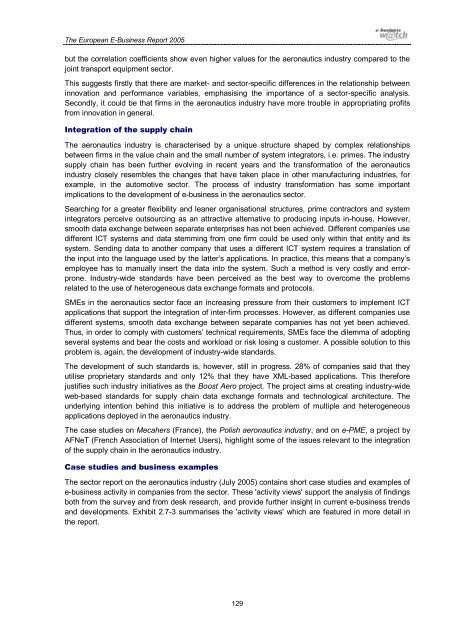The European e-Business Report The European e ... - empirica
The European e-Business Report The European e ... - empirica
The European e-Business Report The European e ... - empirica
You also want an ePaper? Increase the reach of your titles
YUMPU automatically turns print PDFs into web optimized ePapers that Google loves.
<strong>The</strong> <strong>European</strong> E-<strong>Business</strong> <strong>Report</strong> 2005<br />
but the correlation coefficients show even higher values for the aeronautics industry compared to the<br />
joint transport equipment sector.<br />
This suggests firstly that there are market- and sector-specific differences in the relationship between<br />
innovation and performance variables, emphasising the importance of a sector-specific analysis.<br />
Secondly, it could be that firms in the aeronautics industry have more trouble in appropriating profits<br />
from innovation in general.<br />
Integration of the supply chain<br />
<strong>The</strong> aeronautics industry is characterised by a unique structure shaped by complex relationships<br />
between firms in the value chain and the small number of system integrators, i.e. primes. <strong>The</strong> industry<br />
supply chain has been further evolving in recent years and the transformation of the aeronautics<br />
industry closely resembles the changes that have taken place in other manufacturing industries, for<br />
example, in the automotive sector. <strong>The</strong> process of industry transformation has some important<br />
implications to the development of e-business in the aeronautics sector.<br />
Searching for a greater flexibility and leaner organisational structures, prime contractors and system<br />
integrators perceive outsourcing as an attractive alternative to producing inputs in-house. However,<br />
smooth data exchange between separate enterprises has not been achieved. Different companies use<br />
different ICT systems and data stemming from one firm could be used only within that entity and its<br />
system. Sending data to another company that uses a different ICT system requires a translation of<br />
the input into the language used by the latter’s applications. In practice, this means that a company’s<br />
employee has to manually insert the data into the system. Such a method is very costly and errorprone.<br />
Industry-wide standards have been perceived as the best way to overcome the problems<br />
related to the use of heterogeneous data exchange formats and protocols.<br />
SMEs in the aeronautics sector face an increasing pressure from their customers to implement ICT<br />
applications that support the integration of inter-firm processes. However, as different companies use<br />
different systems, smooth data exchange between separate companies has not yet been achieved.<br />
Thus, in order to comply with customers’ technical requirements, SMEs face the dilemma of adopting<br />
several systems and bear the costs and workload or risk losing a customer. A possible solution to this<br />
problem is, again, the development of industry-wide standards.<br />
<strong>The</strong> development of such standards is, however, still in progress. 28% of companies said that they<br />
utilise proprietary standards and only 12% that they have XML-based applications. This therefore<br />
justifies such industry initiatives as the Boost Aero project. <strong>The</strong> project aims at creating industry-wide<br />
web-based standards for supply chain data exchange formats and technological architecture. <strong>The</strong><br />
underlying intention behind this initiative is to address the problem of multiple and heterogeneous<br />
applications deployed in the aeronautics industry.<br />
<strong>The</strong> case studies on Mecahers (France), the Polish aeronautics industry, and on e-PME, a project by<br />
AFNeT (French Association of Internet Users), highlight some of the issues relevant to the integration<br />
of the supply chain in the aeronautics industry.<br />
Case studies and business examples<br />
<strong>The</strong> sector report on the aeronautics industry (July 2005) contains short case studies and examples of<br />
e-business activity in companies from the sector. <strong>The</strong>se 'activity views' support the analysis of findings<br />
both from the survey and from desk research, and provide further insight in current e-business trends<br />
and developments. Exhibit 2.7-3 summarises the 'activity views' which are featured in more detail in<br />
the report.<br />
129

















